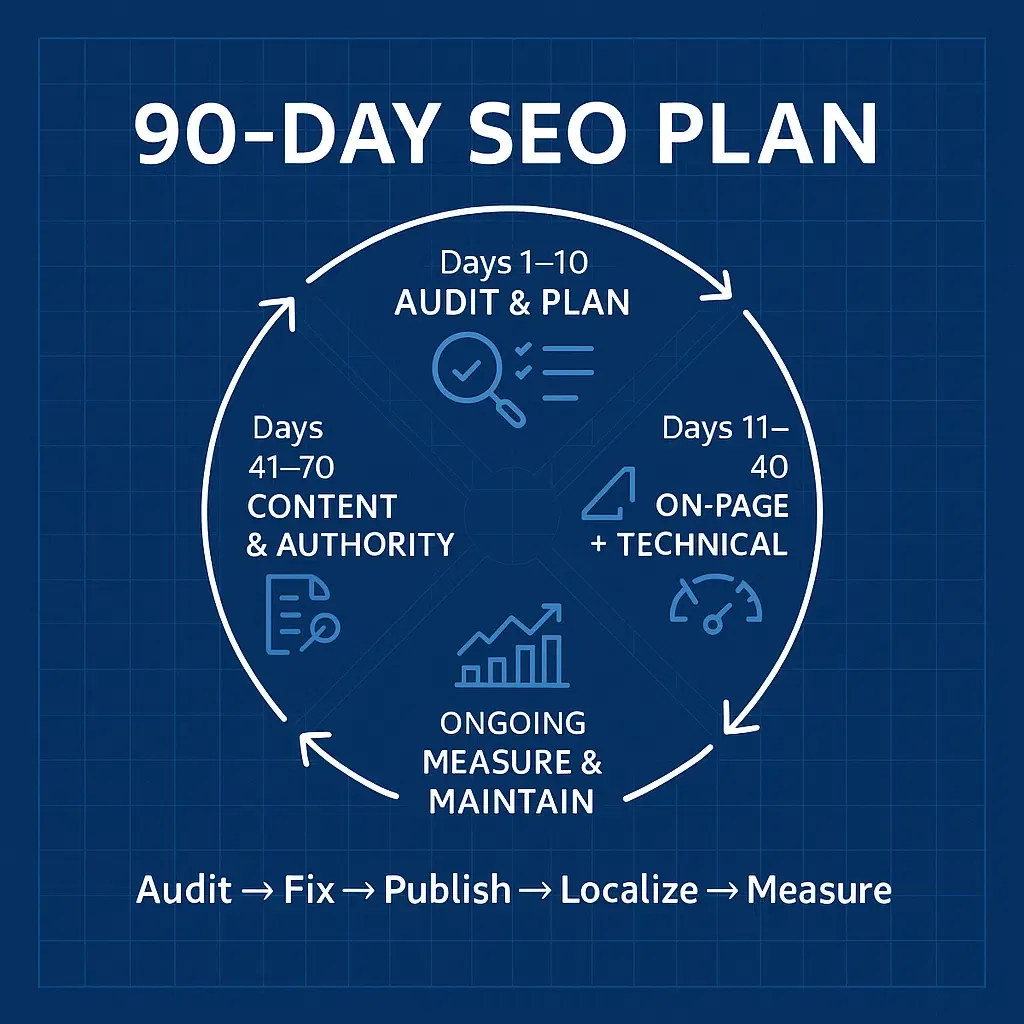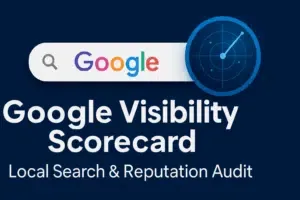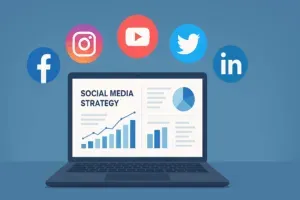The Four Pillars of SEO (and How to Make Each One Work)
Search keeps changing – AI answers, richer SERPs, map packs—but the fundamentals of getting found haven’t. Winning visibility still comes down to four levers you control: make each page unmistakably relevant to a searcher’s intent, earn real-world signals that you’re credible, remove technical friction so bots and people can access your content fast, and show up as the best option nearby when location matters.
What are the Four Pillars of SEO?
“The four pillars of SEO are On-Page SEO, Off-Page SEO, Technical SEO, and Local SEO. Each represents a core area of optimization that must work together for sustainable rankings, traffic, and conversions.”
Think of these as the four pillars of a single system. If any one is weak, performance is capped; when all four are aligned, rankings, clicks, and conversions compound. Below are crisp definitions of each pillar—On-Page, Off-Page, Technical, and Local—followed by practical actions and metrics so you can put them to work in a coordinated plan.
Quick Definitions of the Four Pillars of SEO
Quick Definitions of the Four Pillars of SEO
- On-Page SEO: Optimizing individual pages so search engines and people clearly understand your topic and value (content, headings, keywords, internal links, UX).
- Off-Page SEO: Earning authority signals from outside your site (links, mentions, PR, reviews, partnerships) to boost trust and rankings.
- Technical SEO: Ensuring your site can be discovered, crawled, rendered, and indexed efficiently (speed, Core Web Vitals, sitemaps, structured data).
- Local SEO: Improving visibility for searches with local intent (Google Business Profile, NAP consistency, reviews, local links, proximity relevance).
Why the four pillars work best together
Search today is a system: relevance (on-page) meets trust (off-page) on a fast, crawlable site (technical) that’s aligned with searcher location (local) when geography matters. Treat these pillars as a stack. If one is weak—thin content, slow pages, zero local proof—performance is capped. The playbook below keeps them moving in sync.
Content isn’t just for users and search engines anymore—it also needs to be answer-ready for AI. See how this plays out in our breakdown of Answer Engine Optimization vs. Generative Engine Optimization.
On-Page SEO: Make every page unmistakably about one thing
Goal: Communicate topical relevance and satisfy search intent.
How to do it
- Map one primary intent per URL (informational, commercial, transactional, navigational).
- Use clear titles & H1s with natural keywords; front-load the core topic.
- Structure content with H2/H3s, scannable lists, and crisp paragraphs.
- Add supporting entities/terms (synonyms, subtopics, FAQs) to cover the subject thoroughly.
- Link out to helpful sources and inward to related pages to reinforce topical clusters.
- Include compelling meta descriptions to raise CTR (benefit + qualifier + action).
- Add schema where relevant (Article, FAQ, Product, LocalBusiness) to enhance rich results.
What to measure
- Primary keyword rank & impressions
- Click-through rate (CTR) from SERPs
- Engagement (time on page, scroll depth) & conversions tied to the page
Off-Page SEO: Prove you’re credible
Goal: Accumulate external signals that you’re trustworthy and notable.
How to do it
- Build linkable assets (original data, calculators, process guides, checklists).
- Pursue digital PR: pitch insights, local stories, or expert commentary to relevant outlets.
- Earn contextual links via guest features, partnerships, and community sponsorships.
- Encourage brand mentions and co-citations even when links aren’t guaranteed.
- For local businesses, solicit real reviews and respond to them; surface them on-site.
What to measure
- Referring domains (quality and topical fit, not just quantity)
- Share of voice in key publications/communities
- Review volume, rating, and response time (for local)
Technical SEO: Be discoverable, fast, and indexable
Goal: Remove friction for bots and users.
How to do it
- Ensure clean crawl paths (no orphan pages; fix broken links; logical internal linking).
- Maintain XML sitemaps and an accurate robots.txt; watch for accidental noindex.
- Improve Core Web Vitals (LCP, CLS, INP): compress images, lazy-load, optimize fonts, trim JS.
- Use canonical tags for duplicates and hreflang for multilingual setups.
- Implement structured data to clarify entities and relationships.
- Monitor server health (uptime, 5xx/4xx spikes) and redirect hygiene.
What to measure
- Index coverage and crawl stats
- Core Web Vitals passing rate
- Server response & time to first byte; overall page load outcomes
Local SEO: Be the best answer nearby
Goal: Win map/pack and proximity-based results.
How to do it
- Fully optimize your Google Business Profile (categories, services, photos, hours).
- Keep NAP (Name, Address, Phone) consistent across major directories.
- Publish localized content (service pages by city, case studies with local proof).
- Gather authentic reviews and reply with specifics; post updates/offers.
- Build local links and mentions (sponsorships, chambers, events, local media).
- Add LocalBusiness schema and embed a map on key pages.
What to measure
- Map pack rankings for target terms
- Calls, direction requests, messages from GBP
- Review velocity, rating, and keyword-rich review content
The pillars remain essential, but AI is changing how content is created and discovered. Explore practical tactics in our guide to AI content creation.
A simple 90-day rollout plan
Days 1–10: Audit & plan
- Baseline: rankings, CTR, site speed, coverage, GBP insights.
- Prioritize by impact: top 10 URLs and top local terms.
Days 11–40: On-page + technical fixes
- Rewrite titles/H1s, tighten intros, add FAQs and internal links.
- Ship speed wins: compress media, defer noncritical JS, fix Core Web Vitals offenders.
- Implement schema across priority pages.
Days 41–70: Content & authority
- Publish 4–8 high-intent pages/posts that complete your topical cluster.
- Launch one linkable asset; pitch 10–20 relevant publications/partners.
- Systematize review requests after conversions or service completion.
Days 71–90: Local & iteration
- Expand localized pages (city/service combos with proof elements).
- Tune GBP services, products, Q&A, and post cadence.
- Review KPI movement; double-down on what’s compounding.

Five Common SEO mistakes (and fast fixes)
- Vague pages that try to rank for everything.
Fix: one clear intent per URL; build supporting pages instead of stuffing topics. - Thin internal linking and dead-end content.
Fix: add links from hubs to spokes and back; surface “related” blocks. - Chasing links over quality.
Fix: earn links by publishing genuinely useful assets; avoid irrelevant placements. - Ignoring speed because “it’s good enough.”
Fix: audit real templates (home, blog, product, service) and fix largest assets first. - Set-and-forget GBP.
Fix: weekly posts, prompt review replies, update photos/services seasonally.
Bringing it all together
Think flywheel: precise on-page work increases relevance; off-page endorsements raise authority; technical clarity boosts crawlability and UX; local proof gets you chosen nearby. Keep shipping small, high-signal improvements, measure weekly, and let momentum compound. That’s how you make every part of SEO actually work together.
Let’s turn this framework into growth. Request a free mini-audit and order your 90-day SEO plan. Together we’ll pinpoint your top 10 opportunity pages, the 3 highest-impact technical fixes, and the local moves to win the map pack – then you choose: DIY with our guidance or done-for-you package.
FAQ's about the Four Pillars of SEO
What are the four main types of SEO?
On-Page SEO (optimize the page), Off-Page SEO (earn authority via links and mentions), Technical SEO (crawlability, speed, structured data), and Local SEO (visibility for searches with local intent such as map/pack results).
Which pillar should I tackle first?
Fix technical blockers so pages can be crawled and indexed, then tighten on-page relevance. Build authority off-page and strengthen local signals in parallel if you serve a region.
How long does SEO take to work?
Technical and on-page fixes can move the needle in weeks. Durable gains usually compound over 3–6 months as new content, links, and reviews accumulate.
What KPIs should I track?
On-Page: rankings, impressions, CTR, conversions. Off-Page: referring domains and topical fit. Technical: Core Web Vitals, index coverage, crawl stats. Local: map rankings, calls, directions, review velocity.
Do I need backlinks to rank?
For low-competition terms, strong content and technicals may suffice. Competitive queries typically require authoritative, relevant links and brand mentions.
What is Local SEO and who needs it?
Local SEO improves visibility for searches with geographic intent. Any business serving a location—contractors, clinics, law firms, shops—benefits from Google Business Profile, reviews, and local citations.
What are Core Web Vitals and why do they matter?
They are UX metrics (LCP, CLS, INP) that reflect load speed, visual stability, and interactivity. Better vitals reduce bounce and support rankings and conversions.
How should I structure a page for On-Page SEO?
Map one intent per URL. Use clear titles/H1s, organized H2/H3s, cover related subtopics and FAQs, add internal links, and implement relevant schema.
What role does Google Business Profile play?
It is the cornerstone of Local SEO. Complete categories and services, post updates, collect and respond to reviews, add photos, and keep NAP data consistent.
Can I do SEO without blogging?
Yes. Service pages, FAQs, case studies, and guides can build topical authority. Blogging helps answer emerging questions and attract links but isn’t mandatory.
What does a 90-day SEO plan look like?
Days 1–10: audit and plan. Days 11–40: ship on-page and technical fixes. Days 41–70: publish content and build authority. Days 71–90: localize, iterate, and measure.
Common mistakes to avoid?
One page targeting too many topics, weak internal linking, chasing low-quality links, ignoring speed, and set-and-forget Google Business Profile.

Michael Klasno is SERP Sniper – Building local optimized websites for Attorneys, Law Firms and Business Professionals in Houston and Southeast Texas.
Michael Klasno is a consummate Search Engine Optimization (SEO) Specialist with an impressive 20-year tenure in the digital marketing landscape. Throughout two decades, Michael has been at the forefront of evolving website design & SEO strategies, seamlessly integrating the latest trends with time-tested methodologies.
His SEO expertise encompasses a vast array of skills, including keyword research, technical SEO, (both on-page and off-page) Local SEO, Google Business Profile optimization, SEO auditing, competitive analysis, and content strategy formulation.
“By building a cost effective corporate or business website that looks great and has a high conversion rate you can dominate the organic search results.”



